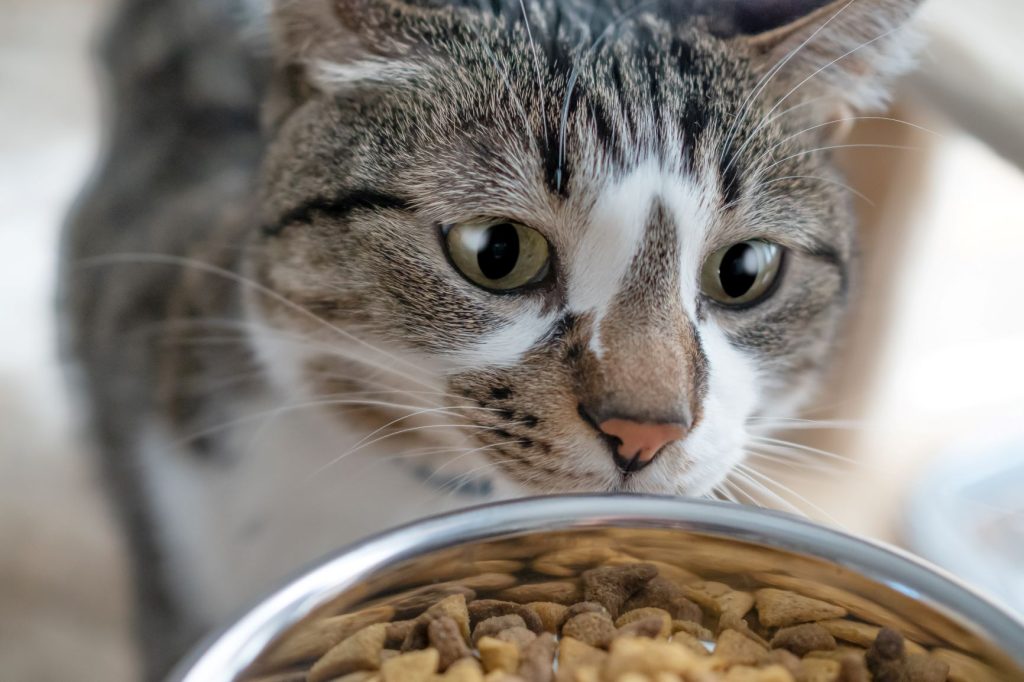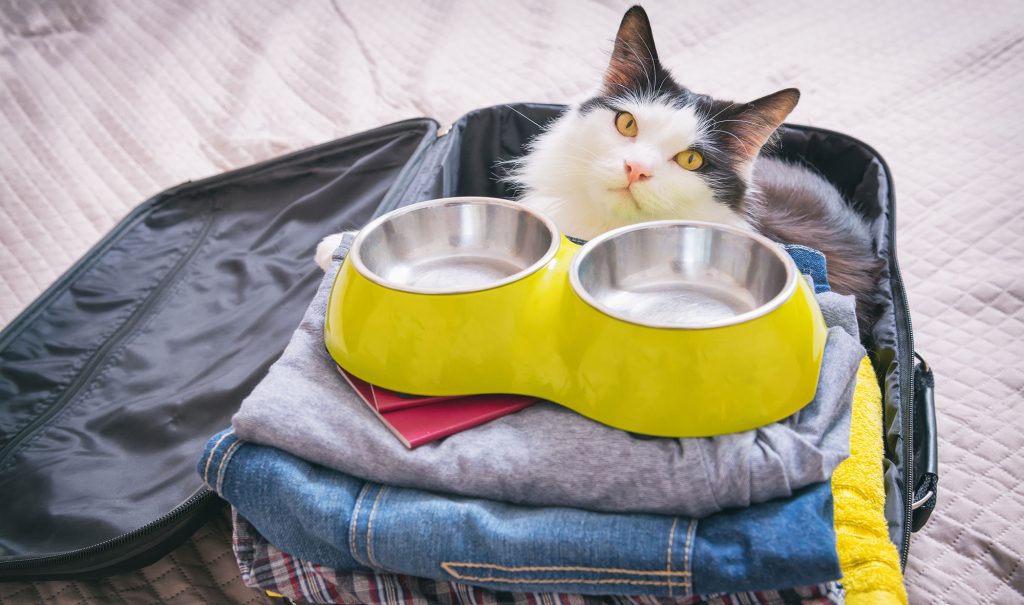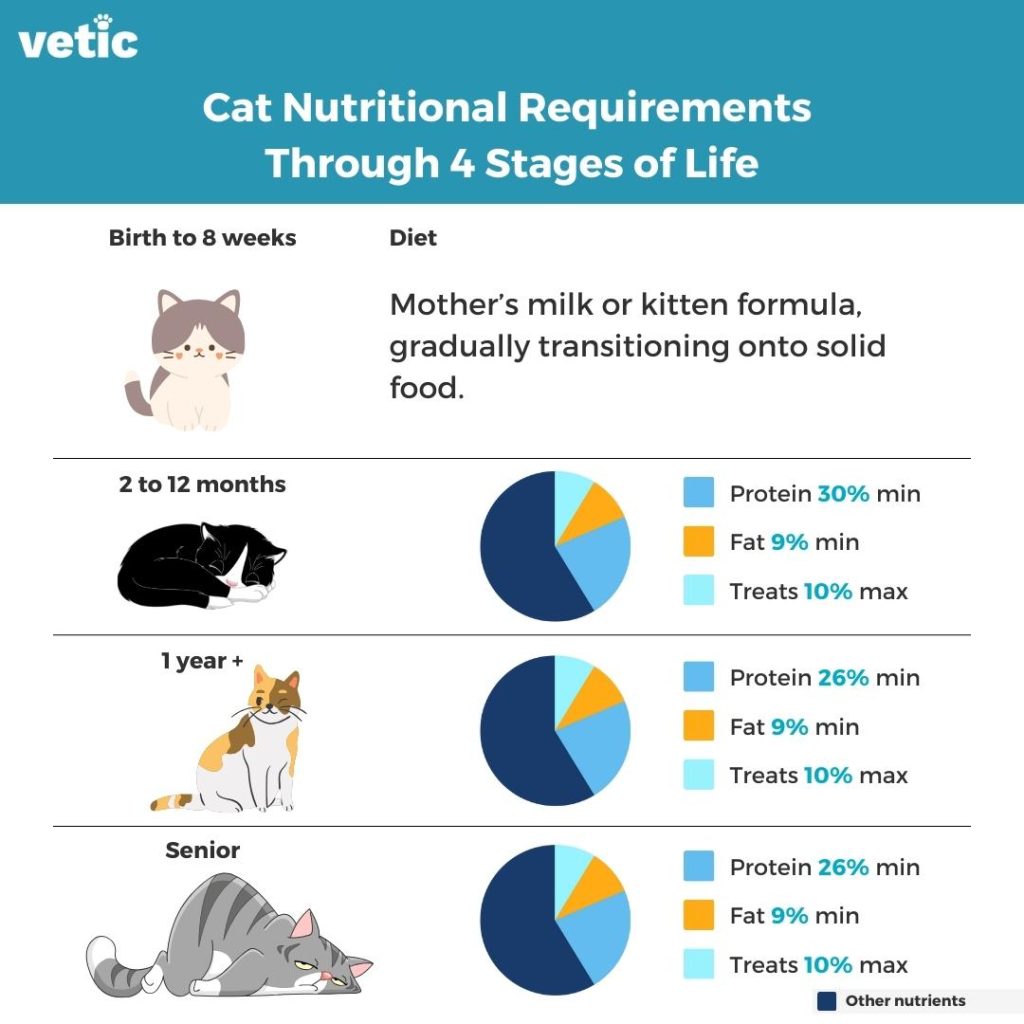Are you planning a road trip soon? You might be happy to know that road trips with your cat are not only an option but can also be a great bonding experience.
You don’t have to find a cat sitter to give your cat, and your feline friend won’t miss you because he’ll be right there with you. However, as with any adventure, it’s important to be prepared!
Here are tips that can help you and your kitten have the best, safest and most fun road trip together!

Table of Contents
Give kitty food and water before the road trip
Offer your cat food and water before going out on the open road. Give Kitty time to use the litter box after eating.
If your cat suffers from motion sickness, feed him a light snack.
NOTE: If your cat is likely to become very sick in a car, it is better to withhold food and water starting about eight hours before the collision. You may want to consider other options and speak to your veterinarian.
Nutrition tips for cats before traveling
Stop giving the cat food five hours before departure. Offer your cat fresh water if you are out for more than five hours.
If cats start panting or yawning on winding roads, give the animals something to swallow or chew. On mountain routes it can be due to ear pressure. If your pet regularly eats a certain food, then you should keep it that way even when you are on vacation. Take enough of it with you if it is not guaranteed that you will get the product at your vacation destination. There are cats that are used to a fairly varied diet. However, changing their diet can also be a problem for them. They should first get used to the changed climate and then to the changed food. So: take something with you at least for the first few days.

Food for on the go
Dry food is also good to take with you. If your animal is not used to this, start an adjustment phase two weeks before departure. High temperatures also put a strain on the animal’s circulation. Therefore, reduce the portions so that your animal does not have to waste too much energy on digestion. For a snack on mountain or hiking tours, the feed industry offers wonderfully packaged bags that can be easily stored in your backpack.
Never give dry food without water
To avoid trouble, do not use the hotel or landlord’s dishes to feed your pet. Keep the feeding area itself clean. This shouldn’t be the maid’s job. If possible, have the meal outdoors. Don’t forget the can opener, or use food that opens without it. Make sure your animal does not eat on the street. Cruel customs prevail, particularly in countries such as Greece and Spain, and poison bait is often laid out for stray animals all year round. If your animal has a change in behavior or stool, please consult a veterinarian immediately.

Don’t give cats anything to eat before departure – Air travel
If your dog and cat are traveling by plane, it is better not to feed them six hours beforehand. Because that could easily affect the animals’ stomachs or circulation. Small amounts of water, on the other hand, are very important, explains Birgitt Thiesmann from the Four Paws organization. However, owners should make sure that the drinking bowl in the transport cage is only filled to such an extent that the liquid cannot spill out.
If it’s very hot, it’s best to take a flight in the morning or evening if possible. On the one hand, when you fly to the south, the temperature at your destination is not that high. On the other hand, there is no cooling or ventilation in the cargo holds of the airline. The four-legged friends may be exposed to stuffy and heated air for a long time.
No sedatives during the trip
Veterinarians now advise against using strong sedatives while driving or flying. The cat still notices the loud noises and unusual movements, but at the same time notices that it is physically unable to escape the situation. This only increases the fear and nervousness.
Instead, serve for gentle calming pheromone sprays such as from Feliway otherwise Bach flowers for cats. Supplementary feed containing the amino acid tryptophan can also promote the release of the happiness hormone serotin in the brain, thereby leading to more calmness.
Less sensitive cats can be calmed down by the mere presence of their caregivers and by good persuasion.

10 Important things you should remember to feed your cat while traveling
When traveling with your cat, it’s essential to ensure they have access to suitable food to keep them nourished and comfortable. Here are some options for give your cat during travel:
- Bring Your Cat’s Regular Food:
- Pack enough of your cat’s regular dry and wet food to last the duration of the trip. Familiar food can help maintain their routine and reduce the risk of digestive upset.
- Portion Meals:
- Portion your cat’s meals in advance, especially if the journey involves multiple days. Pre-portioning helps prevent overfeeding and makes feeding more convenient during travel.
- Use Travel Bowls:
- Invest in collapsible or portable travel bowls. These bowls are easy to pack and can be used to serve both dry and wet food. They are also convenient for providing water during stops.
- Special Travel Treats:
- Bring along some of your cat’s favorite treats to reward good behavior or to entice them to eat if they seem stressed. However, don’t rely solely on treats for their nutrition.
- Consider Wet Food Pouches:
- Single-serve wet food pouches are convenient for travel and can be served directly from the pouch. Choose high-quality, easily portable options.
- Hydration is Key:
- Ensure your cat stays hydrated during travel. Bring a supply of fresh water in a spill-proof container. Offer water during breaks or rest stops.
- Stick to Routine:
- Try to maintain your cat’s feeding routine as much as possible. Feed them at the same times you would at home to provide a sense of normalcy.
- Monitor Eating Habits:
- Keep an eye on your cat’s eating habits during travel. Changes in appetite or refusal to eat may indicate stress or discomfort, so monitor their behavior closely.
- Choose Familiar Brands:
- Stick to the same brands and flavors of food your cat is used to. Introducing new foods during travel may lead to digestive issues.
- Ask Your Vet for Recommendations:
- If your cat has specific dietary needs or health concerns, consult with your veterinarian before traveling. They can provide guidance on the best way to meet your cat’s nutritional requirements.
Remember that traveling can be stressful for cats, and changes in routine may affect their eating habits. Creating a comfortable and familiar environment within the carrier, offering their favorite food, and maintaining a calm demeanor can help ease the travel experience for your feline companion. If you have concerns about your cat’s nutrition or behavior during travel, consult with your veterinarian for personalized advice.

Prioritize the nutritional needs of your cat
When traveling with your cat, it’s important to prioritize their nutritional needs while considering the challenges of being on the road. Here are some additional tips:
- Pack Adequate Food:
- Ensure you have enough of your cat’s regular food to last the entire trip. Calculate the daily portion and pack a bit extra in case of unexpected delays.
- Familiar Brands and Flavors:
- Stick to the same brands and flavors of cat feed that your cat is accustomed to. Sudden changes in diet can lead to digestive upset.
- Travel-Safe Treats:
- Bring along some of your cat’s favorite treats. Treats can be useful for positive reinforcement, especially during stressful situations.
- Hydration is Crucial:
- Cats can be prone to dehydration, so ensure they have access to fresh water during the journey. Use a spill-proof travel water bowl and offer water during breaks.
- Consider Wet Food Pouches:
- Single-serve wet food pouches are convenient for travel. They are easy to open, serve, and dispose of, minimizing mess and fuss.
- Portable Food and Water Bowls:
- Invest in collapsible or portable travel bowls for both food and water. These are lightweight, easy to clean, and won’t take up much space in your travel bag.
- Maintain Routine:
- Stick to your cat’s regular feeding schedule as closely as possible. Consistency can help reduce stress during travel.
- Monitor for Stress or Discomfort:
- Cats may be stressed during travel. Monitor their behavior, including eating habits. If your cat refuses to eat or shows signs of distress, it’s essential to address the underlying cause.
- Consult with Your Vet:
- If your cat has specific dietary requirements or health concerns, consult with your veterinarian before the trip. They can provide advice tailored to your cat’s needs.
Remember that every cat is unique, and what works for one may not work for another. It’s essential to be attentive to your cat’s behavior and adjust your approach based on their individual preferences and needs. Traveling with a familiar blanket or toy can also provide comfort to your cat during the journey.
FAQs
Q: What should I feed my cat before traveling?
A: It’s best to feed your cat a light meal a few hours before traveling to help prevent motion sickness. Avoid giving your cat a large meal right before traveling to minimize the risk of an upset stomach.
Q: How can I get my cat used to travel in a carrier?
A: Start by placing the carrier in a familiar and comfortable area of your home and gradually introduce your cat to it by placing treats, toys, or even a cozy blanket inside. Let your cat explore the carrier at its own pace to help it become more comfortable with the space.
Q: What are some tips for traveling with a cat in a car?
A: It’s important to properly secure the cat carrier in the car to ensure your cat’s safety. Additionally, consider using a pheromone spray or diffuser to help keep your cat calm during the journey. Make sure to take regular breaks to allow your cat to stretch and use the litter box if needed.
Q: Can I give my cat medication to help with travel anxiety?
A: It’s best to consult with your veterinarian before giving your cat any medication for travel anxiety. Your veterinarian can provide guidance on safe and appropriate options for your cat’s specific needs.
Q: What can I do to make flying with my cat less stressful?
A: Before flying, make sure to check the airline’s requirements for traveling with a cat, including the need for a health certificate and updated vaccinations. Additionally, consider using products like Feliway to help keep your cat calm during the flight.
Q: How can I help my cat stay calm while traveling by plane?
A: In addition to using products like Feliway, you can also place a familiar item, such as a blanket or toy, inside the cat carrier to provide comfort and reassurance to your cat during the flight.
Q: Is it safe to bring my cat’s favorite treats for the journey?
A: Bringing your cat’s favorite treats can provide comfort and distraction during travel. Just be mindful of the portion size and avoid overfeeding, especially if your cat is prone to motion sickness.
Q: Should I let my cat out of the carrier during travel?
A: It’s best to keep your cat securely inside the carrier during travel, as it helps ensure your cat’s safety and prevents potential escape or injury. However, you can offer reassurance by talking to your cat and providing comfort from outside the carrier.
Q: What should I do if my cat gets anxious during travel?
A: If your cat shows signs of anxiety during travel, such as pacing or vocalizing, try to provide a calming presence and soothing reassurance. Avoid raising your voice or using harsh discipline, as this can further stress your cat.
Q: How can I ensure my cat stays safe and secure while traveling?
A: Make sure the cat carrier is properly secured in the car or airplane, and consider using a harness and leash if you need to take your cat out of the carrier. Additionally, place a familiar item, such as a blanket or toy, inside the carrier to provide comfort and reassurance to your cat.